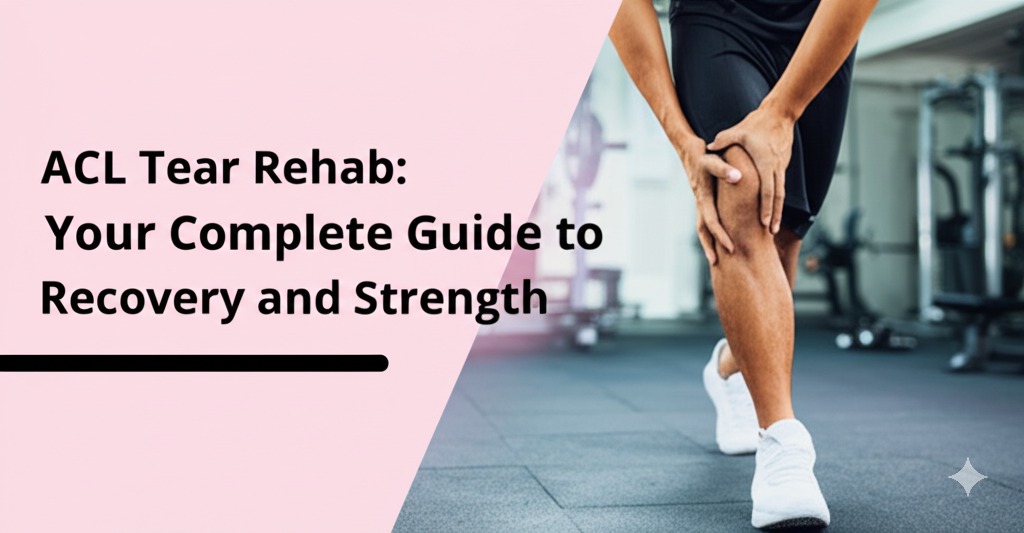An ACL tear can feel like a life-altering injury, especially for athletes and active individuals. But with the right rehabilitation plan, it’s absolutely possible to bounce back stronger. Whether you’ve just been diagnosed, recently had surgery, or are already on the path to recovery, understanding the rehab process is key to a successful return to activity.
In this guide, we’ll break down ACL tear rehab step-by-step, from early recovery to full return to sports, so you know exactly what to expect and how to stay motivated.
What Is the ACL and Why Does It Matter?
The anterior cruciate ligament (ACL) is one of the four main ligaments that stabilize your knee joint. It helps control the back-and-forth motion and prevents the shinbone from sliding out in front of the thighbone.
When the ACL is torn, it can lead to:
- Knee instability
- Swelling and pain
- Loss of range of motion
- Difficulty walking, running, or pivoting
Most ACL tears occur during sports that involve sudden stops, jumps, or changes in direction—like soccer, basketball, or skiing.
Do All ACL Tears Require Surgery?
Not necessarily. While ACL reconstruction surgery is common, especially for athletes or those with unstable knees, some people can manage without surgery through focused rehab and lifestyle adjustments.
Surgical vs. non-surgical rehab decisions depend on:
- Activity level
- Extent of tear
- Age and overall health
- Knee stability post-injury
Always consult with an orthopedic specialist to determine the best route for your recovery.
Phases of ACL Tear Rehab
Rehabilitation after an ACL tear typically follows structured phases designed to restore strength, stability, and mobility.
Phase 1: Early Recovery (0–2 Weeks Post-Injury or Post-Surgery)
Goals:
- Reduce swelling
- Restore knee extension (straightening)
- Begin gentle movement
Tips:
- Use ice packs and elevation to manage swelling.
- Wear a brace or use crutches if recommended.
- Begin range-of-motion exercises under the guidance of a physical therapist.
Phase 2: Regaining Mobility and Strength (2–6 Weeks)
Focus areas:
- Improve knee flexion (bending)
- Start light strength training
- Begin weight-bearing as tolerated
Common exercises:
- Heel slides
- Quad sets
- Stationary biking
- Gentle balance drills
Phase 3: Strength and Control (6–12 Weeks)
Objective:
- Build muscle strength around the knee
- Improve balance and proprioception
Key components:
- Closed-chain exercises like squats and step-ups
- Core strengthening
- Resistance band training
Consistency is crucial during this phase to support joint stability and avoid setbacks.
Phase 4: Advanced Strength and Agility (3–6 Months)
What to expect:
- Higher-intensity workouts
- Sport-specific drills
- Plyometric training (jumping and explosive movements)
This stage bridges the gap between basic strength and return-to-play readiness.
Phase 5: Return to Sport (6+ Months)
Before returning to sports, you’ll undergo functional testing to ensure your knee can handle dynamic movements.
Clearance may involve:
- Hop tests
- Strength symmetry evaluations
- Psychological readiness assessments
Many athletes return around the 9–12 month mark, depending on progress and sport demands.
Tips for a Successful ACL Rehab Journey
Rehab isn’t just physical—it’s mental too. Here are some proven strategies to stay on track:
- Stick to your rehab plan: Skipping exercises delays recovery.
- Celebrate small wins: Every milestone counts—from bending your knee to your first jog.
- Work with a sports therapist: They tailor exercises to your goals and help you avoid re-injury.
- Stay positive: Mindset matters. Stay focused, even on tough days.
- Fuel your body: Eat nutrient-rich foods and stay hydrated to support healing.
When to Call Your Doctor
Reach out to your healthcare provider if you experience:
- Persistent swelling or sharp pain
- Fever or signs of infection (especially post-surgery)
- Difficulty moving the knee after several weeks
- New instability or a “giving way” sensation
Early intervention helps prevent complications and promotes long-term knee health.
ACL Rehab FAQs
How long does ACL rehab take?
Typically, 6 to 12 months, depending on the type of treatment and your personal goals.
Can you walk with a torn ACL?
Yes, some people can walk with a torn ACL, but it may feel unstable. A brace may be recommended early on.
Is physical therapy necessary after ACL surgery?
Absolutely. Physical therapy is essential for rebuilding strength and regaining function after surgery.
Conclusion: Reclaim Your Strength and Confidence
Recovering from an ACL tear is a journey—but it’s one you don’t have to take alone. With a structured rehab plan, the right support team, and a determined mindset, you can return to the activities you love.
Start strong, stay committed, and trust the process.
If you’re beginning your rehab or planning surgery, speak to your physical therapist or orthopedic specialist today to map out your personalized recovery plan.

Kallie Snyder is an author at Stonegate Health Rehab, providing valuable insights, recovery guidance, and rehab resources to help individuals achieve better health and well-being.
